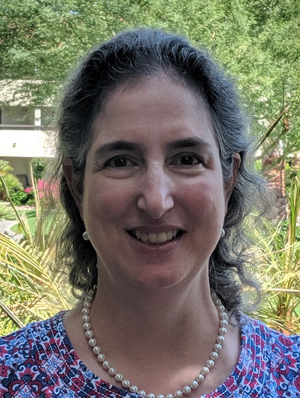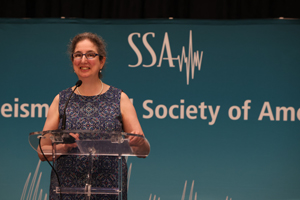19 July 2023–Like all scientific disciplines, seismology is not immune to trends. And right now, creeping faults are having a bit of a moment, according to Ruth Harris.
The topic is a long-time research interest of Harris, a Senior Scientist with the U.S. Geological Survey’s Earthquake Science Center and president of SSA. She describes creeping faults as “faults which are slowly moving all of the time. This is in contrast to how we think of regular faults as working, with long periods of being stuck in place, then suddenly sliding during earthquakes.”
 “A big question is if the existence of creep—slow continuous sliding–throughout the depths of some faults means that large earthquakes will be more confined on these faults, and less likely to become runaway events,” she noted. “In subduction zones this also relates to how often earthquakes rupturing up a fault from the depths below are able to breach Earth’s surface and generate tsunamis.”
“A big question is if the existence of creep—slow continuous sliding–throughout the depths of some faults means that large earthquakes will be more confined on these faults, and less likely to become runaway events,” she noted. “In subduction zones this also relates to how often earthquakes rupturing up a fault from the depths below are able to breach Earth’s surface and generate tsunamis.”
A serendipitous meeting at USGS in Menlo Park, when Harris was looking for a job after graduating with her master’s degree in geophysics, was her introduction to studying creeping faults. A scientist there “popped his head out of his doorway saying that he had some funds and was looking for someone to work with him,” she recalled. “I accepted his offer of a temporary job, moved to California two months later, and the next things I knew, I was learning about and working on a famous creeping fault site on one of the world’s most famous faults, the San Andreas.”
Harris and other scientists at USGS and University of California, Berkeley made a number of discoveries along the Parkfield creeping section of the San Andreas, “and it seemed like we understood why, when and where it might produce the next magnitude 6 earthquake,” she said.
But as Parkfield remained quiet, enthusiasm for studying creeping faults dropped off, Harris said.
“Luckily though, visionary scientists had instrumented this part of the San Andreas fault, and a few persistent voices were able to keep the instruments running on a shoestring budget, even when funding was running out,” she said. “We were then rewarded with the best recorded earthquake on a creeping fault, when the next magnitude 6 Parkfield earthquake did finally occur, in 2004.”
Harris said creeping faults have become popular to study again, “especially after people inferred that there is slow fault slip occurring at the base of major earthquake faults. This has led to a resurgence of interest in what happens for faults which creep throughout their depths, or creep closer to the Earth’s surface.”
Harris’ work in physics-based dynamic rupture simulations of earthquakes—another major research focus—has changed over time with the dramatic rise in available computing power and data on specific fault zones and earthquakes. When researchers first worked on these kinds of simulations 50 years ago, she said, “back then they just had a chance to do a few simulations, on the best supercomputers of the day, so 99% of the thinking had to occur beforehand.”
Researchers like Harris can now run thousands of simulations using high-performance computing resources, but “I think though that it is still best to do most of our thinking first,” she said.
Seismology and Earth sciences weren’t Harris’ first career choices growing up. “As a middle schooler, I read the biographies of the famous astronomers of the current and previous century, and my father encouraged an interest in the field, taking me and my siblings to talks at the observatory a few blocks away.”
She went to MIT hoping to major in astronomy, but switched to planetary sciences after finding some physics professors less supportive—“except of students they envisioned as future Nobel laureates”– than her math professors. MIT’s then-Department of Earth and Planetary Sciences “was a small group, we also had the coolest major on campus,” she recalled. She took some planetary classes, “then landed on Earth, particularly geophysics.”

In the coming academic year, Harris will be giving Zoom talks on seismology to colleges, including Historically Black Colleges and Universities (HBCUs) with students from underrepresented groups in the Earth sciences. “I will be asking for lots of advice about how I can do the best job,” she said. “I tend to present my work in a manner that is hopefully understandable to everyone, and usually I do OK, although an occasional rideshare driver who has asked me about earthquakes has not always believed my answers.”
This is Harris’ second stint as president of SSA, which she calls her home professional society.
“SSA is just the right size, it is not too small and not too big. This allows us to easily communicate in our seismology communities, to make a difference and to get things done,” she said. “The SSA Executive Director and staff are excellent, our journal editors are dedicated, and we have many, many enthusiastic and thoughtful members.”
During her time in office she will be working with others “so that SRL and BSSA authors also have an open access option, while maintaining financial stability for our professional society.” [The Seismic Record is already an open access journal.]
“My top priority is that we continue to grow our efforts to do even better, as an inclusive and welcoming professional community,” said Harris.
SSA At Work is a monthly column that follows the careers of SSA members. For the full list of issues, head to our At Work page.
